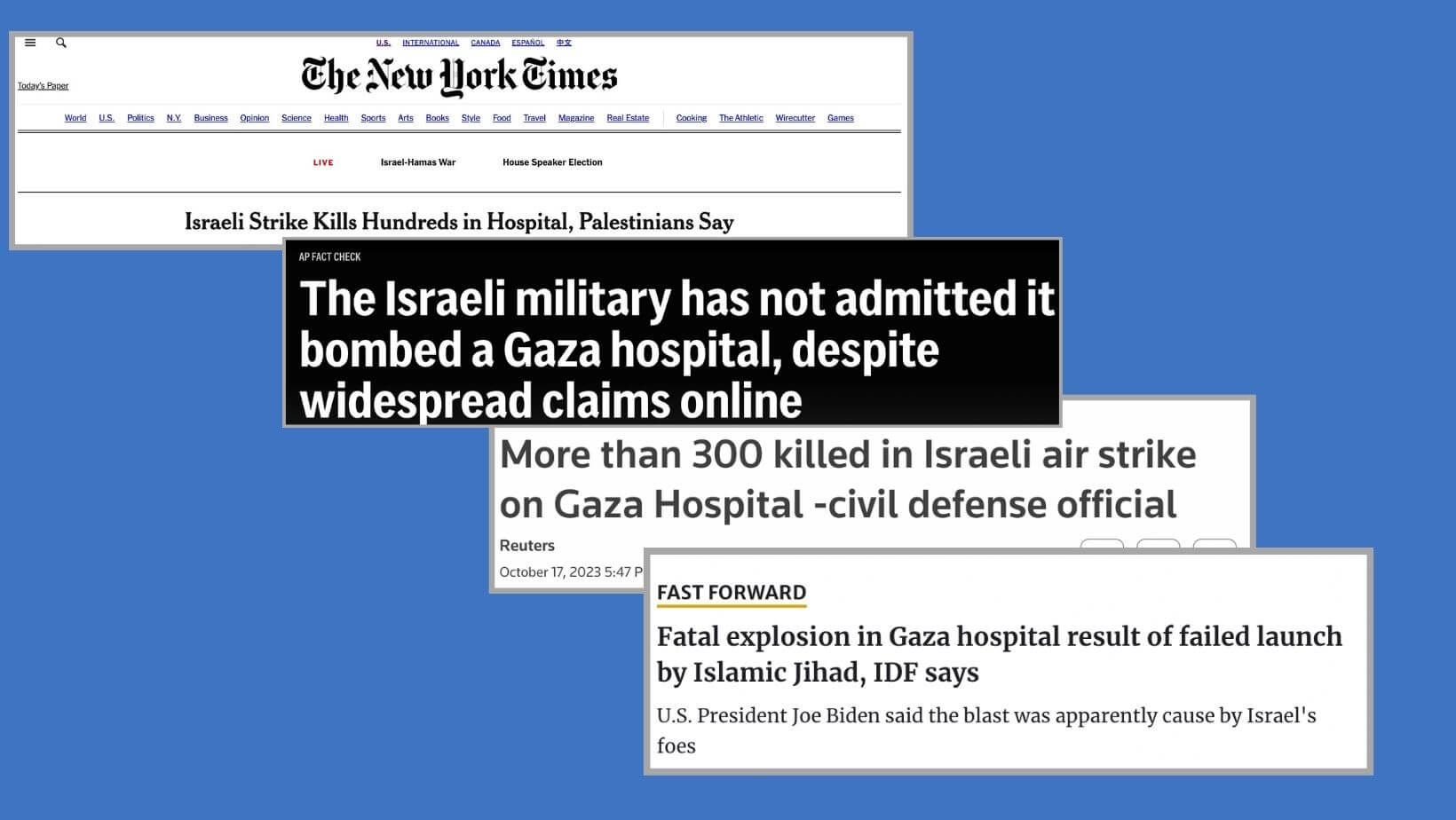Gaza hospital explosion poses questions about how to report to readers who don’t read
Journalists rely on tricks of the trade like attributions to imply doubt, but are readers paying attention?

A few initial headlines from the day of the hospital explosion. Graphic by Mira Fox
“According to an eyewitness account.” “Israeli officials said in a statement.” “Reportedly.” “Said a student on the condition of anonymity.” “Per Palestinian officials.” “Some experts say.”
For journalists, attributions like these are a crucial tool intended to provide clarity and context. They demonstrate where an idea came from, and whether it might contain bias. Often, they indicate — but do not say directly — that the information has not been independently verified.
But most people do not consume journalism like journalists; their eyes may glaze past attributions to focus on the more substantive information before or after them.
In our current era of digital media, news spreads across social platforms fast and haphazardly, and can often be distorted by advocates with an agenda. Algorithms favor outrage and hot takes, leaving consumers with little space to think for themselves. This is especially true for hot topics like the Israeli-Palestinian conflict — and it can have consequences.
“Based on what we know about how people react to media,” said Yotam Ophir, a professor of communications at the University of Buffalo, “most people won’t distinguish between a statement attributed to Hamas” and one attributed to a more reliable source — or even one that is unattributed.
The issue of attribution, and the reliability of Hamas as a source, got a lot of attention this week after The New York Times published a rare editor’s note saying that its initial coverage of a controversial hospital explosion in Gaza “left readers with an incorrect impression.” The report, and particularly a banner headline and push alert about the explosion, “relied too heavily on claims by Hamas,” the note said, and “did not make clear that those claims could not immediately be verified.”
That breaking news headline — “Israeli Strike Kills Hundreds in Hospital, Palestinian Officials Say” — was updated several times over the course of a few hours; eventually the phrase “Israeli strike” was removed. U.S. intelligence officials and some independent analysts now believe the explosion was likely caused by a rocket misfired from within Gaza, which hit a parking lot, not the hospital itself, and killed fewer people than originally reported. Note that I’m including the word “likely,” because the information is not conclusive — no munitions have yet been recovered from the blast site.
The Times was not alone in its framing; numerous other news outlets, including The Associated Press, Reuters and the BBC all initially reported the news as an Israeli strike that killed hundreds. The BBC has since issued an apology.
Meanwhile, Vanity Fair published an article revealing some Slack messages from the Times newsroom that revealed a robust debate over the initial headline. Some editors felt that the headline made clear that the claim of Israeli responsibility was unverified, while others thought the attribution was too vague — it said “Palestinian officials,” and didn’t specify that they were Hamas — and too late in the headline.
In response to concerns that the headline “went too far,” one senior news editor responded: “We’re attributing.”
But when I spoke with friends about the hospital explosion, many insisted that the initial Times headline definitively assigned responsibility to Israel in the Times’ own voice, and did not attribute the statement at all. This is not true; the headline attributed the claim to “Palestinian officials.” But my friends didn’t register an extra clause that meant little to them.
This may seem small, but it’s indicative of a much larger dilemma faced by all journalism outlets: Our tricks of the trade — some built to provide transparency — are not always working as we intend.
Ophir, who is Israeli and works in Buffalo’s Media Effects, Misinformation, & Extremism Lab, said that most people consume news out of context, often reading only the headline and never clicking into the story. Often, the story isn’t even there to click on, with news simply streaming across people’s social media feeds in the form of screenshots and influencer-made infographics.
“It’s important to remember that we’re no longer in the time when people sit down with a newspaper and carefully read through it,” he said. “What happens online is, if the Times puts up a headline that is sensational, emotionally engaging, they share it. Most of the people who read the Times headline aren’t even Times subscribers; they’re scrolling on Twitter and headlines pop up out of their original context and their original chronological order.”
Similarly, as journalists update news stories to add new information or more nuance — especially in live-update formats, such as the one the Times story used — those updates do not always have as wide a reach as the initial report.
“So now, the headline is almost having a life of its own,” Ophir noted, “independent of the editorial decision making of the Times, and independent of all the features that the Times has on its website to stay up to date.”
Some of this is because of confirmation bias — people don’t want to share the updates if they don’t fit into the narrative they’ve already chosen. “Once you make up your mind, it’s quite a challenge to change it,” Ophir said. “You adopt information to tell you you’re right, and you push away information that tells you you are wrong.”
That’s what happened around the Gaza hospital explosion. When outlets updated their stories to add uncertainty and explain that there were conflicting accounts about responsibility, some social media commenters called the changes “cowardly.”
It’s clear that publishing news in our current era requires speed — and accuracy. Some of the brightest minds of our time seem to be boggled on how to counteract the way misinformation spreads online. Distrust in the media is high as well, making it easier for people to shrug off information they don’t like, or feel as though they know better than the fact-checkers. It makes for a toxic soup of misinformation, partial information and echo chambers.
This can feel like an impossible equation to balance, but it’s also clear that both journalists and readers need to grapple with it. As journalists, our job is to emphasize facts — and, when necessary, emphasize uncertainty — in an effort to slow the hunger for hot takes in the 24-hour news cycle. Attribution is one of our tools; we must deploy it responsibly and clearly.
Most of all, we must try to practice what Ophir called “modesty.” Journalists must be modest about the facts, and readers must be modest about their expertise, which means reading carefully. Including — some experts say — the attributions.
















